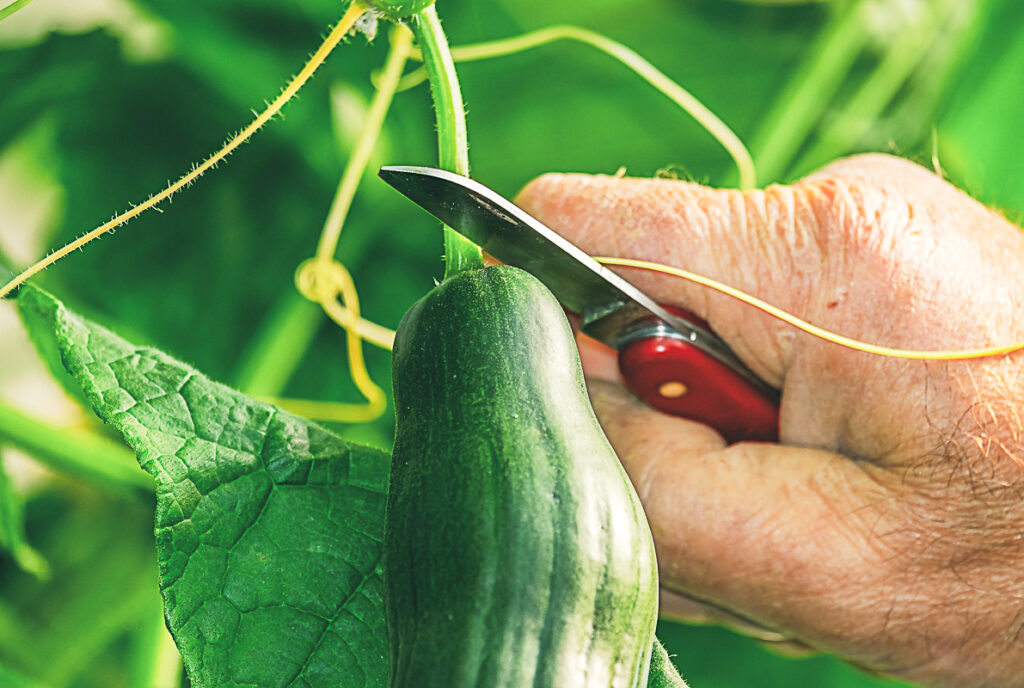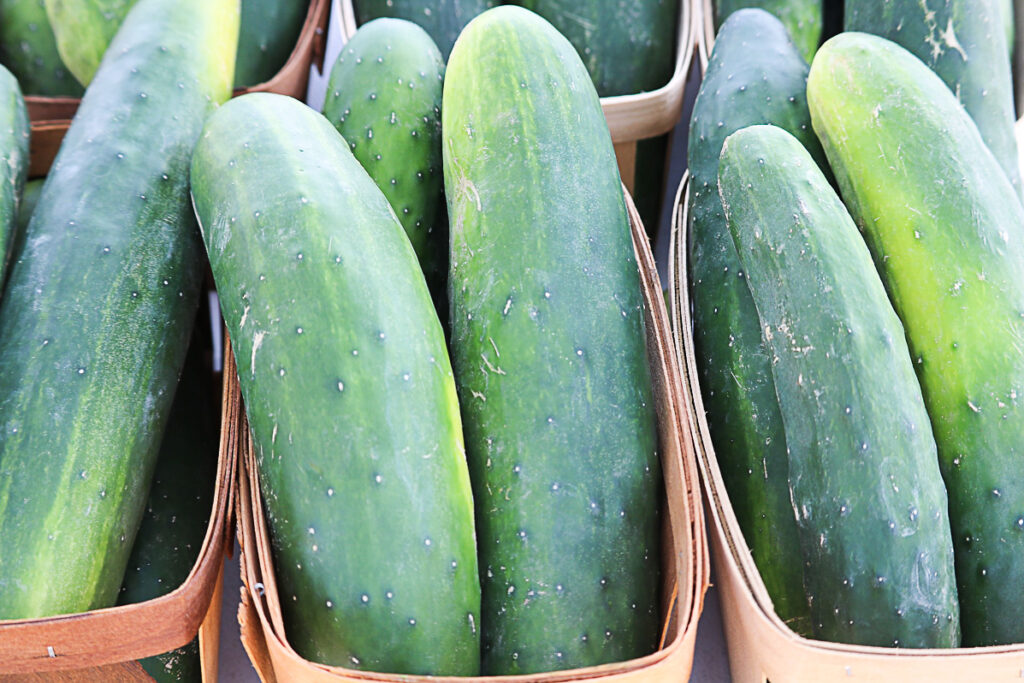Most gardeners save the hassle of growing cucumbers in soil and opt for hydroponic gardening, thanks to technology. Hydroponic cucumbers are grown in either nutrient-rich water or a soilless medium consisting of coconut fiber, Rockwool, peat, sand, or perlite. Cucumbers are among the vegetables that do extremely well when grown hydroponically.
*This post contains compensated links. Find more info in my DISCLAIMER. As an Amazon Associate, I earn from qualifying purchases.
Want to start a hydroponic garden at home easily? Check out our recommendations for Best Hydroponics Starter Kits for Beginners.
How To Grow Hydroponic Cucumbers At Home
Hydroponics for cucumbers has a lot of benefits for home gardeners. These include but are not limited to rapid and vigorous growth, high yields, and reduced pest and disease incidences.
Using Seeds Vs. Saplings

Cucumber seeds germinate easily, fast, uniformly, and their seedlings grow fast too. The seeds take approximately 5-10 days to germinate under ideal temperatures of 70-85℉.
You can sow the seeds directly in any suitable hydroponic production substrate or medium. Transplanting can be done once the plants have four mature seeds and are planted in containers with nutrient-rich water, sand, coconut coir, or suitable soilless media.
Cucumbers can also be grown from saplings. However, root disturbance can make it difficult when transplanting, making this method less effective.
Want to grow other vegetables at home? Check these out:
Growing Tomatoes At Home Using Hydroponics
Spacing Requirements
Cucumbers should be grown in a spacious place. Growing them should be done in patches, 3-6 feet apart, depending on the cucumber variety. Varieties that vine on the ground should be given more space.
Use 3-4 feet apart spacing for container and bush varieties, whereas vertically-growing varieties only need a couple of feet. This means it is best to grow cucumbers outdoors or in a greenhouse space that offers room to grow.
The Best Nutrients For Cucumbers
To ensure good vegetative growth, fertilizer application is essential. Dyna Gro Grow is among the most common nutrient solutions for hydroponic cucumbers. It is the best fertilizer to start off until the plants are set to produce flowers.
During the flowering and fruit production stages, use a fertilizer with more phosphorus and potassium but less nitrogen.
The best nutrients for hydroponic cucumbers are hydroponic fertilizers and not general-purpose fertilizers. The hydroponic nutrients in these fertilizers help balance the nutrient solution’s acidity and alkalinity.
This is where science comes in. The recommended amounts are 0.5 pounds of N:P:K in the ratio 10:8:22. In addition to that, add 2 ounces of magnesium sulfate that is mixed in 10 water gallons.
Another alternative fertilizer is a mixture of 2 ounces of magnesium sulfate, 3 ounces of 3:16:36 hydroponic fertilizer, and 3 ounces of calcium nitrate.
Growing Different Cucumber Varieties

Any cucumber variety can do well when grown in hydroponics. However, the variety choice is based on your garden setup or the purpose.
The best cucumber varieties that grow well under hydroponics include bush varieties like Spacemaster, Bush Champion, Beit Alpha cucumbers, Lebanese cucumbers, apple cucumbers, and lemon cucumbers.
Older varieties may have a bitter taste when left on the vine for prolonged periods. Therefore, any gardener can duplicate hydroponic cucumbers by growing hybrid varieties that produce seedless fruits without fertilization. These are the Dutch-type cucumber cultivars.
Cucumbers can also be grouped according to the growing areas, including indoors/greenhouses or outdoors.
Growing cucumbers indoors is best for varieties such as Emilie, a medium-sized cucumber with soft skin, and Telegraph Improved, dark in color, classic, and long-yielding.
There are also mini cucumbers, also called gherkins, which grow perfectly well in greenhouses. These include Mini Munch and Cornichon de Paris.
Outdoor or ridge varieties include Crystal Apple, round or oval with yellow skins, and Burpless Tasty Green, a delicious variety despite the name.
How To Pollinate Cucumbers
Cucumbers produce flowers with male and female parts on separate flowers. This makes them what is known as monoecious plants.
Pollination is mainly done manually because the flowers can easily be distinguished. Male flowers are made up of flower clusters without cucumbers at the base, whereas female flowers have a small cucumber below the flowers.
For cucumbers in hydroponics, you can use two methods to pollinate. You can use a small paintbrush to rub the male flowers gently and then transfer the pollen to the female flowers. Alternatively, you can also pluck the male flowers and rub them on the female flowers.
Using Lights For Growing Hydroponic Cucumbers
The large growth of cucumbers is due to high energy intake, which increases fruit production. Plenty of light, 12-14 hours of full sun daily, will achieve maximum productivity.
Supplemental lighting, full-spectrum fluorescent can be used to grow in areas that do not receive enough sunlight.
The lights are turned on for 12 to 16 hours daily. These lights should be turned on in the daytime and turned off once it gets dark outside. Ensure the plants are positioned 4 to 6 inches just below the lights.
The Best Temperature For Cucumbers
Light and temperature go hand-in-hand in hydroponic gardening. This cucumber cultivation method requires high to medium light levels alongside warm temperatures. You can achieve this by growing them during summer.
Alternatively, greenhouse cucumbers can also be grown. The advantage is that temperature and light are controllable in greenhouses.
Maximum growth for the Dutch type is achieved with daytime temperatures ranging between 75-80℉ and night temperatures above 65℉. Beit Alpha varieties can withstand any temperature range between 50-100℉.
For proper cucumber seed germination, the ideal soil temperature should not fall below 60℉ and have a PH level range of 5.0-6.0.
They are highly vulnerable to temperatures below 55℉, which usually cause a chill. This is often noticeable when there is pitting, decay, or water-soaked lesions. It’s best to try to avoid going below this temperature.
Our 5 Top Tips For Growing Hydroponic Cucumbers
Besides the above-mentioned light, temperature, nutrient, and soil requirements, cucumbers also require training, pruning, thinning, and harvesting. Here are our five tips all home gardeners should know before starting to grow cucumbers in a hydroponic system at home.
Training Cucumbers
There are at least three methods for training cucumbers. Each has its advantages and produces different yields. The easiest method is the drape method. Using the drape method, vines are trained onto a piece of vine twine. Then, the moment the vine reaches the trellis wire, they get trained over the wire to grow in a downward direction.
The umbrella method is where the farmer trains cucumbers up the trellis wire, they are pinched off, and two stems drape over the trellis wire and grow downwards.
Another method is the V-cordon method. Here, the trellis wire is pushed away from the stems of the plant.
As the stems grow up the trellis wire into aisles at an angle. This method is ideal for maximum light interception when the plants are grown under low light.
Pruning Cucumbers
Pruning cucumbers is done by regularly removing the plant tendrils. Failure to prune will result in challenges in vine maintenance.
It would be best if you also pruned outside branches, flowers, leaves, and fruits to balance vine growth and fruit production.
You should thin fruits from greenhouse cucumbers to leave one fruit to grow at each leaf to maintain the fruits’ quality.
Picking Cucumbers
When to pick cucumbers depends on the cultivars. Beit Alpha varieties are harvested when the fruits are 4-8 inches long.
Other varieties may go up to 14 inches long. Picking the cucumbers should be done frequently to ensure the fruits are of good size, avoid crop loads, and enhance normal fruit growth.
Harvesting The Cucumbers
Now the best part. Harvesting can be done 12 weeks from planting and harvested fresh, preferably early in the morning—harvest by carefully cutting them at the base using a sharp knife.
Preventing Disease In The Cucumbers
Disease in cucumbers, just like any other fruit, is a common occurrence, especially with high humidity levels. The plants are highly susceptible to powdery mildew, anthracnose, bacterial wilt, and mosaic viruses.
It would be best if you did careful scouting to identify pests such as thrips, whiteflies, cucumber beetles, and aphids. Biological control methods can be of great help or incorporate yellow sticky traps.
The Best Hydroponic Systems For Growing Cucumbers At Home
Incorporating these systems will depend on the cucumber variety and choice of location. Growing them outdoors is easier and more manageable because there is more space.
Less space is required between the plants because they can grow vertically easily. Use drip systems, bubble buckets, large ebb and flow systems, and Dutch bucket systems.
Outdoor cucumbers are heavy during fruiting and usually have large root systems. This is why they are ill-suited for rail and NFT systems.
Growing them indoors means the space is limited; thus, bush variety is highly recommended. Ebb and flow systems work well indoors.
Home Hydroponics For Cucumbers
Hydroponic cucumbers are very easy to cultivate, require fewer maintenance practices, grow fast, and are high-yielding. Provided that the growing conditions are favorable, expect cucumbers at your table during any meal!
FAQs – Growing Hydroponic Cucumbers
100% yes. In fact, cucumbers are one the easiest vegetables to grow hydroponically. This makes the perfect vegetable to grow for new home gardeners or home gardeners with limited space.
Depending on the growing conditions, it will take between 60-70 days for cucumbers to be grown hydroponically. Growing time can vary by the type of cucumber, but this is the amount of time you should plan for when attempting to grow cucumbers hydroponically.
This all depends on the type of cucumber you are growing. There are nearly 100 varieties of cucumbers. Many of these types of cucumbers are seedless. If they are seedless or not does not depend on the method in which you grow them.
